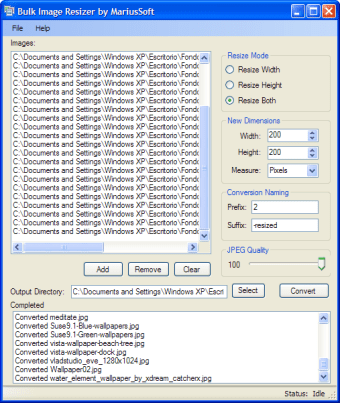

Many would say that from around 240-300 the average eye on the average printer is not going to see a difference.and beyond 300 ppi it would take extraordinary equipment, and human eyes, and magnification.to see a difference. But once you know your minimum acceptable print resolution.then you can resize that file to anything up to that maximum size.or smaller.getting progressively MORE PPI resolution the smaller you go. Some might say THEIR minimum is 200.or whatever. That would.at 150 PPI.allow a print of 30" x 20". There is, roughly, a range from around 150 PPI and upward that will produce acceptable pending on size, use, and pickiness. The SIZE of the file, the more X's and y's determines roughly how large you can print, depending on what output resolution on the picture you can live with. When you go to print, you still have that basic xxxx by yyyy file (in whatever initially chosen output resolution) to work with. The 72 ppi computer/screen is looking at those 300 ppi and down-sampling (throwing away the excess) to 72 ppi to project it on the screen. Another camera, or yours if re-set, might choose 300 ppi as its output resolution Same exact xxxx by yyyy file.just will show as a 15" x 10" picture on your computer screen. Your camera is producing an image file of xxxx by yyyy pixels and is simple choosing (and you might change this internally in the cameras software.if you want.but once you understand it it is rather meaningless) 72 ppi as a STARTING POINT output resolution. In reality that leads to an impossible amount of scrolling. At 72 pixels per inch (PPI) it would show on your (72 PPI) computer screen as a 62.5" x 41.7 " picture.if your screen were that large. Say you have a a 14MP print, consisting of 4500 x 3000 pixels.

What dimensions would your printed photo be at 72 pixels per inch? What dimension will your printed photo be at 300 pixels per inch?Įveryone is trying to explain the elephant to you from different perspectives. The 300 pixels per inch resolution needed for a photo will change based on the size of the photo you are printing (i.e.
#BATCH IMAGE RESIZE PHOTOSHOP SERIES#
Your photos are a series of colored pixels. You might want to contact the lab you intend on using for more information on ideal photo resolution and what they do to your photos to prepare them for printing.

If you up sample the image yourself, your lab may very well up sample again. If you doubled the ppi to 144 ppi, you would reduce the dimensions of the print unless you up sampled it. The resolution of the file is what matters for printing. Rogers: I know that monitors and anything related to a computing devices (iphone, ipad, laptop, etc.) default to 72 ppi (or somewhere around there) and so changing the ppi to a higher number will not make a difference for email, facebook or anytype of computer viewing.ĭon't worry about the 72 ppi (display resolution). Finally, opt for the ‘Image Processor’ option.Ok Mr. From the drop-down menu, choose ‘Scripts’. Once you open Photoshop, you will see the ‘File’ option at the top navigation bar. So let’s get weaving! Step 1: Select Image Processor In just a few steps, you can successfully complete this action of creating a photoshop batch save as jpg. Steps in creating photoshop batch save as jpg The Batch feature allows you to edit a series of multiple files together and save them according to the format you like, whether it’s JPEG, PSD, or even TIFF.
#BATCH IMAGE RESIZE PHOTOSHOP SOFTWARE#
What would you do? Google different software and convert each file individually. Suppose you want to convert the format of a group of files to jpeg.


 0 kommentar(er)
0 kommentar(er)
